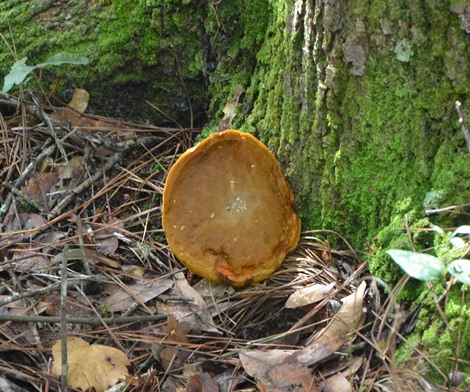
by Les Harrison | Oct 8, 2019

Mushrooms growing on the roots of trees is a bad sign. This indicates the roots are decaying and the tree will soon become (or already is) unsafe.
On the doorstep of autumn, the weather is making its seasonal change in north Florida. It has been a bit cooler in the mornings, but the afternoons still qualify as hot.
What the winds of October will blow in is still anyone’s guess, but last year it was Hurricane Michael. Unfortunately, the storm’s brunt came in causing severe damage to homes, businesses and marine enterprises in several counties.
October is typically the month when tropical cyclone activity lessens in the Atlantic, but accelerates in the Gulf of Mexico. While beastly events like Hurricane Michael are relatively rare, it only takes one such incident to necessitate recovery efforts and expenses for years, if not decades.
The prudent course of action is to prepare for the worst while hoping for the best. One area of preparation where residents can have a distinctly positive effect is readying their trees for the potential assault.
Damage from falling trees and limbs is a major cause of destruction during tropical storms and hurricanes. Removing potential problems before the storm can minimize harm to structures and injury to residents.
Trees in decline are especially hazardous. Their compromised health makes them subject to uprooting and breakage with far less force than would effect a healthy tree.
There are several key indicators for tree health. Any single factor or a combination can mark a tree as unsafe.
Mushrooms growing on or very close to trees is a sign the tree is dying. The fungus is not the cause of decline, but only an indicator of the eventual fate.
Spores of the mushrooms are scattered by wind and water. Landing randomly, most arrive on a site devoid of necessary resources and never sprout.
Those lucky spores which land on decaying wood will likely sprout and take nourishment from the rotting plant material. Their roots accelerate the decomposition of the wood by consuming the available material and exposing more of the tree to colonization by mushrooms.
Sites on trees and plants infected with mushrooms typically are break points when pressure or stress is applied. If the mushrooms are located at the base of the tree, it is likely to be detached from its roots and topple over in heavy winds.
Another indicator of tree health is its crown, or the uppermost branches and leaves. Healthy trees and plants have full, green, and growing crowns.
When the crown turns brown and the leaves drop off, it is a good indicator the tree’s days are numbered. The causes may be disease, lightning, or mechanical interruption of the root system.
Lastly, bifurcation or trunk forking is a sign of a structurally weak tree. This condition may display itself when the tree emerges from the ground or at an elevated place on the mature tree trunk.
When the wind direction stresses the tree with enough force at its angle of vulnerability, a collapse results. Unfortunately, there is no simple way to tell how much wind is required to produce the failure.
Any tree with these problems should be evaluated by a certified arborist and removed when necessary. It may result in an expense now, but can save on expenses, inconvenience and aggravation if a storm randomly removes the tree in the future.
The question must be asked: Is it worth the gamble to wait on the winds of October?
To learn more about the tree health in north Florida, read the UF/IFAS publication HOW TREES GROW IN AN URBAN ENVIRONMENT.

by Les Harrison | Aug 10, 2018

Looks, as the old saying goes, can be deceiving. It is a cautionary pronouncement from experience, usually painful and expensive, to serve as a warning to those who follow and hopefully avoid similar complications if they listen.
In most situations a threat in nature can be easily identified and avoided with a little effort. Except for those situations where the careless or clueless individual blunders into problems, a little observation and logic dictates the potential outcome from a close encounter.
Yellow jackets have stingers, so they must stink something. Alligators would not have all those large and pointed teeth unless they needed to bite something.
Those assumptions are easily deduced by anyone who uses even the slightest quantity of judgement and forethought. Unfortunately, there are occasions where the potential agony is disguised by bright colors and a benevolent appearance.
Such is the case with the caterpillar of the Io moth. Automeris io, this insects entomological name, is a large native moth.
This insects’ range extends from south central and maritime Canada to the eastern half of the U.S. It is found in every Florida County, even into the Keys.
The wingspan of this moth can reach an impressive three and a half inches. Males of this species tend to have a slightly brighter appearance than the females.
Both sexes have large eye spot on each hindwing as a defense device. When revealed, the spots appear as the eyes of predatory creature meant to bluff other aggressors into retreating.
Adults of this species live only a week or two, so reproduction is a priority activity. Luckily, at least for the parents, there are plenty of host plants in north Florida.
Oaks, sweetgums, redbuds, and ash are among the choice meal sites for the developing caterpillars. The eggs are commonly laid in clusters of 20 or more and the caterpillars go through five development stages before reaching adulthood.
Unlike the parents which are active almost exclusively at night, the larvae spend their days hidden in the tree leaves they are consuming. These caterpillars are quite animated and active, frequently seen moving inline from one feeding site to another.
Initially orange, they change to a lime green as they mature. They also develop clusters of spine strategically place across their plump bodies.
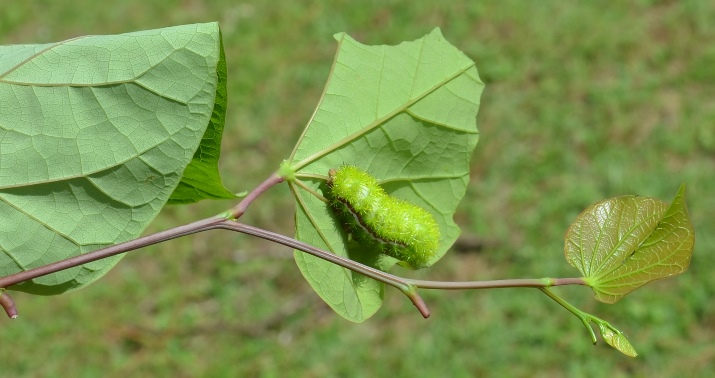
Photo Caption: The colorful Io moth caterpillar is covered by fragile spines. Each contains a painful venom for anyone who physically contact this insect larvae.
Distinct from their parents’ eyespot bluff, the spines are a serious defense designed to assure the caterpillars reach maturity unmolested by birds or other predators which would otherwise find them a suitable snack option.
Unlike a pit viper which injects venom via a syringe-like fang or a stingray which retains its barb in a venom saturated sheath, this caterpillar’s spines work differently. Each spine contains a sac filled with the defensive solution.
When contact is made with the hollow spines, deliberately or accidentally, the fragile structure breaks and releases the toxin. The pain is almost instantaneous, intense, and can be a serious health treat for those who have an allergic reaction.
Not usually seen on the ground this caterpillar can be encountered on lower limbs, to the detriment of the unlucky individual. The colorful, toy-like appearance hides a very different reality.
To learn more about north Florida’s stinging caterpillars, contact the local UF/IFAS County Extension Office. Click here for contact information.

by Les Harrison | May 23, 2018
There is something to be said for being a longtime resident. While it does limit ones outlook from a global perspective, it promotes focus on perfecting applicable traits which are close to home.
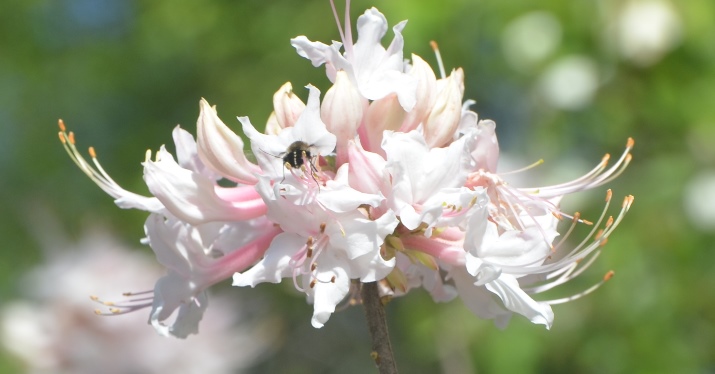
Azalea and bug: Wild Piedmont Azaleas (Rhododendron canescens) and a bumble bee.
The unique, and very pleasant, environment of north Florida is an excellent example of near perfection on a localized basis. The weather (within reason), the fauna and the flora are tailored to a superior quality of life, especially the spring blooming native plants.
The human residents of the panhandle can easily see this in a native plant which blooms in the spring. Wild azaleas make random appearances, but their cultivated cousins from Asia are now the province of retail establishments.
Azaleas are member of the Rhododendron genus which includes flowering shrubs of the same name which grow in more northern latitudes. Their popularity as flowering perennials has led to the development of more than 10,000 cultivars worldwide which please almost every taste for a profuse and showy burst of color.
These plants have species native to southwest Europe, Asia, and North America. They are believed to date back 70 million years and have an ancestor in common with blueberries and pieris.
Many of the azaleas which grace the yards and gardens in the southeast are traced back to east Asian stock. These cultivars had been grown for millennia, but reached Europe in the early 17th Century when wealthy estate owners were seeking a new and unique look to their landscapes.
When azaleas arrived in America there were 26 different native azaleas already growing here. At least four of these grow naturally in Florida and can be presently seen in natural settings, as well as, managed landscapes.
Like the long cultivated Asian varieties, the azaleas native to Florida prefer acidic soils and filtered light. The can be found in forested areas and near streams or rivers.
The native azaleas are rather scraggly and upright when very young, but will spread out and fill in as they mature. The large, dark green leaves bend the branches gently to form a cascading appearance down to the ground.
A single specimen in a formal landscape should be allowed at least four to five feet of spread to develop into its natural form. These plants are very sensitive to dry soil, but the soil should drain freely of excessive moisture.
A thick mulch of three inches deep is recommended to help ensure adequate root growth when cultivated out of their natural environment. Roots are located in the top several inches, even in well-drained sandy soils, so adequate mulching is critical to success.
Pruning of these natives is seldom necessary except to control shoots extending above the normally mounded shape. Azaleas bloom on the previous year’s growth so any pruning should be done after flowering, but before July.
Mass azalea plantings add a stark color contrast to any landscape. The green background of March and April with clusters of boldly bright blossoms is a striking sight.
The wild azaleas add an enduring continuity to the ever-changing landscape in contemporary life. Some things should never change, especially in comfortable north Florida.

by Les Harrison | Apr 23, 2018
Spring 2018 is barely out of the starting gate. All kinds of plants are sprouting and producing blooms! This week’s last gasp of winter temperatures slowed the progress, but only slightly.
Much like the Easter egg hunts a few weeks ago, a search of the landscape can bring multiple surprises. Two colorful plants, spiderwort and rustweed, which are growing in the region fit into this category.
Tradescantia ohiensis, the scientific name for spiderwort, is a herbaceous native plant. Its most striking feature which makes it easily identifiable is the cluster of bright purplish-blue blooms which are currently on display.

Spiderwort in full flower. Image Credit Les Harrison
To the casual listener, the name spiderwort implies an arachnid with a complexion issue. Far from it, but the terminology is shrouded in agriculture and horticulture history.
The term wort, in its various forms, can be traced back to northern Europe to well over 1,000 years ago. Its meaning related at first to herbs, and then to plants without bark or hard stems.
It should not be confused with wart, a skin eruption relating to a virus. Contact with any part of the spiderwort does not infect a person with warts.
The spider part of the name relates to the flower peddles. In harsh sunlight of the afternoon, the Spiderwort’s peddles are reduced to fine threads similar to a spider’s web.
Spiderworts are often seen along fencerows, in pastures and untended fields, and it forested areas. They bloom from late spring to early summer and usually grow in clumps or bunches of plants.
The plant clumps are easily separated and transplanted. Spiderwort has been used in ornamental horticulture as a showy, low-cost alternative for many years.
They expand their presence in the wild slowly, but persistently. Since there are no herbicides labeled for their control, they are considered a pest species by some hay producers.
Another plant with a colorful name, and which is considered a pest, is the rustweed (Polypremum procumbens). While it does not literally rust, it gets its name from its rust colored foliage in the autumn.
In spring and summer this low growing perennial is a Kelly green fitting for St. Patrick’s Day, and easily blends with Bermudagrass and other turfs as they make their season emergence. Tiny white blooms soon to come will confirm it presence, but this is often overlooked when in landscapes and lawns.
This plant spreads by seed, which are small and heart-shaped. One means of colonizing new areas is by seed lodging in mowing and other equipment, then depositing in new areas when the equipment is relocated.
As with all grasses in the Florida panhandle, rustweed is found only in sunny areas. This little known plant is an area native, but also occurs as far away as South America.
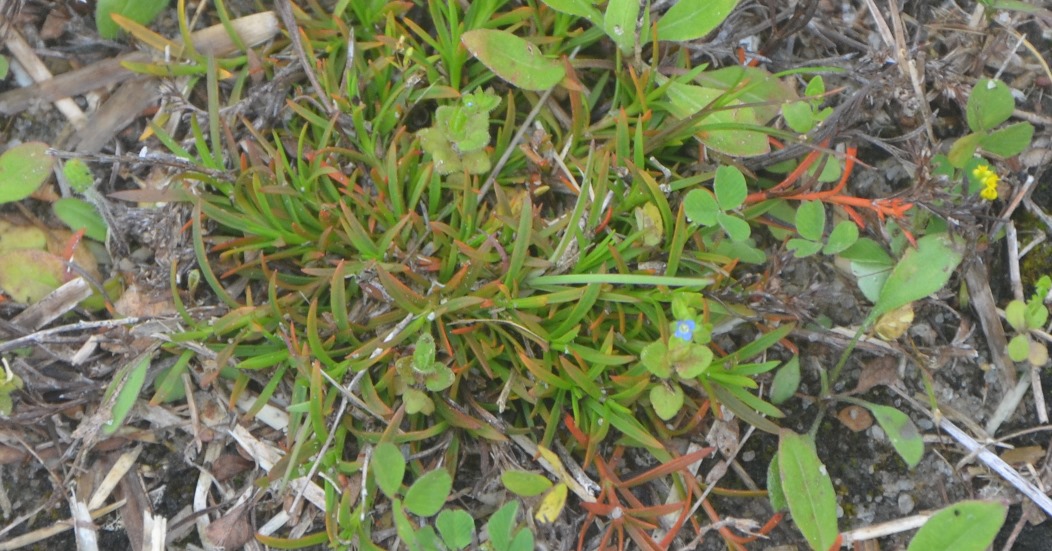
Rustweed, among others, in a Florida lawn. Image Credit Les Harrison
This aggressive native will quickly establish itself and push out other more desirable species. Mowing will not slow its progress.
After the multiple frost and muted earth tones, both spiderwort and rustweed are currently adding variation to the landscape’s hues as the weather warms.
To learn more about weeds in north Florida, contact your local UF/IFAS County Extension Office. Click here for contact information.
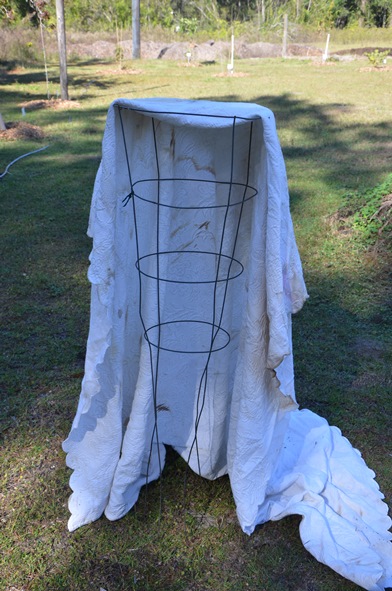
by Les Harrison | Jan 4, 2018
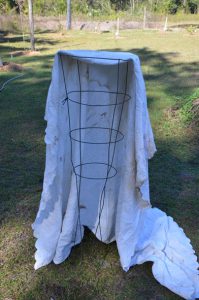
Photo Caption: Unused tomato cages are a perfect support for heavy covers which can protect delicate landscape shrubs during the frosts of winter. When spring arrives, they can again be used to support tomato plants. Image Credit Les Harrison
The Thanksgiving turkey is but a distant memory, the stores are stocking for the spring, and Christmas decorations are coming down.
The advent of the new year, finally brings the inevitability of cold and frosty weather. While nothing complements a nice eggnog or hot chocolate like a chill in the air, some northwest Florida landscape plants do not appreciate the dropping temperatures.
Gardeners face a new set of challenges dealing with the effects of cold weather. However, a little planning and creativity can make plant protection in the landscape a relatively simple process.
Many homeowners and landscape managers want to know when plants will need protection. Depending on the plant, the point of freezing is a good rule of thumb. Freezes will likely occur this season so preparations should begin now.
It is worth noting there is a difference in the terms used for cold weather conditions. Frost, freeze and hard freeze all describe different circumstances.
Frost is when water vapour freezes on surfaces. It usually happens on clear nights with still air and can happen when reported air temperatures are above freezing.
Freezing is when cold air moves in and causes temperatures to drop below 32 degrees Fahrenheit. This condition commonly involves low humidity and wind, making drying out a big problem for plants.
A hard freeze is when temperatures dip below 28 degrees Fahrenheit. Some tropical plants will survive a few degrees below freezing for very short periods, but extended periods of freezing or heavy frost may require lights or other heat used safely in combination with covering the plant.
In the Panhandle, most of the risk for sustaining freeze damage happens during the busy holiday season. People are busy, schedules are disrupted and the distractions, pleasant thought they be, may cause homeowners to miss a critical freeze alert in the media.
Some plants can be moved indoors for the cold months and incorporated into the interior décor, rather than cramming them last-minute into a chaotic bundle when a freeze looms.
While putting away the holiday decorations into storage, identify old sheets, blankets and drop cloths which can be used as covers for tender plants which must remain outside. Test potential covers beforehand to assure all plants will be thoroughly covered.
It is best if the covers enclose the plant entirely without crushing it. Heavy blankets are great insulation, but only a good idea on the sturdiest of plants.
A tomato cage or other support structure can be used to keep the weight off the plant. Covers also need to be secured at the ground with pins or weights to assure cold air does not enter from below and collect under the cover.
Finally, keep storage bins handy and remove the covers in the daytime if temperatures are above 55 degrees Fahrenheit.
Monitor weather reports and react accordingly so your tender and tropical plants see spring 2018. Santa will approve.










